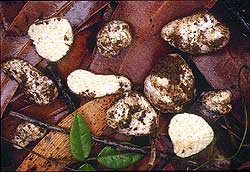World-first Australian truffle find

An Australian scientist has made a discovery which is electrifying world fungal biology – a new truffle genus related to the famous Amanita family, or fairy toadstools.
The Amanita family is famed worldwide for the red and white-spotted toadstools beloved of children’s fairy tales, the lethal Death Cap beloved of tabloid media, and a range of delicious edible fungi beloved of gourmets.
The find, by CSIRO Forestry and Forest Products mycologist Dr Neale Bougher, highlights Australia as one of the richest centers of truffle biodiversity on the planet.
Until Dr Bougher discovered the new fungus in the rejuvenating forest landscape of a former bauxite mine near Perth, WA, no one had ever found a truffle – or underground mushroom – related to Amanita.
“It’s not just a new species. It’s a whole new genus,” he explains. “Scientists have been looking for this round the world for well over a century – and here it is, in Australia.”
Since the original find by Dr Bougher, he and colleague Dr Teresa Lebel of Melbourne’s Royal Botanic Gardens, have identified no fewer than five new species of what has now been scientifically named Amarrendia – a marriage of the names Amanita and Torrendia, the two families of fungi most closely related to the discovery.
The CSIRO researcher was part of a team studying landscape rehabilitation at the Darling Escarpment bauxite mine run by Alcoa World Alumina Australia – regarded as a global benchmark for successful restoration – when he literally unearthed the new genus.
“I had my suspicions the moment I picked it up in the field. I got a bit excited – but I couldn’t be absolutely certain. So I rushed back to the lab and put it under the microscope – and, immediately I saw the characteristic Amanita structures.
“I went crazy. At least, I am sure the people in the lab thought I was crazy. I was yelling “This has got to be a truffle Amanita,” the (normally quite cool) Dr Bougher recalls.
The truffles in question are white and about the size of marbles, though Dr Bougher has since found specimens as large as a decent kiwifruit.
More important for him, however, is what the truffle means for Australia’s environment.
First, it adds to a growing view that Australia is one of the planet’s mega-biodiverse centers for truffles, which are important elements in soil health.
“So far we’ve found nearly 90 genera of truffles and over 300 species here. 35 per cent of the genera and 95 per cent of the species occur nowhere else on Earth,” he says. “That rivals the uniqueness of our plants – and we’re only scratching the surface in what we know about fungi.”
Second, truffles are a favourite food of native marsupials like potoroos and woylies and rely on them to disperse their spores.
Whether the Amarrendia truffles are safe to eat or not is unknown, as Dr Bougher says specimens are so precious every one has been taken into scientific collections. However, as no other truffle has proved poisonous and because they rely on mammals to transport their spores, he thinks it unlikely, in spite of their toxic Amanita relatives. He advises against anyone trying them until this has been checked out, however.
Third, underground fungi, including truffles, are essential to landscape health. Fungi like truffles unlock nutrients for native plants, and break down the tough Australian timber to form fertile new soil. They create hollows in logs where birds and animals can nest, and turn hard wood into food for insects.
Many eucalypts, wattles and sheoaks depend critically on certain fungi, making them a primary factor in the survival and renewal of landscapes. In fact, Dr Bougher argues, we face difficulty repairing and revegetating our landscapes unless the soil fungi are in place to help the trees and shrubs to grow, and nutrient cycling to re-establish. We need to include them in “best practice” restoration planning and operations.
“Many mysteries remain unresolved in the Kingdom of the Fungi – and Australia has a big role to play in helping to unravel them,” he says. “The ’truffle Amanita’ is an example of how much there is to find.
“So far only about ten per cent of Australia’s native fungi are known to science, yet they are one of the most pervasive and important life forms on the continent. ”
The discovery came about as a result of a partnership in landscape restoration between Alcoa World Alumina Australia, Worsley Alumina Pty. Ltd., Murdoch University and CSIRO – highlighting the value of a team approach to science, he adds.
To view a larger version of the image above click here.
More information:
Dr Neale Bougher, CSIRO Forestry & Forest Products, 08 9333 6673
Neale.Bougher@csiro.au
Mick Crowe, CSIRO Forestry & Forest Products, 02 6281 8357, 0419 696 184
Media Contact
All latest news from the category: Life Sciences and Chemistry
Articles and reports from the Life Sciences and chemistry area deal with applied and basic research into modern biology, chemistry and human medicine.
Valuable information can be found on a range of life sciences fields including bacteriology, biochemistry, bionics, bioinformatics, biophysics, biotechnology, genetics, geobotany, human biology, marine biology, microbiology, molecular biology, cellular biology, zoology, bioinorganic chemistry, microchemistry and environmental chemistry.
Newest articles

Time to Leave Home? Revealed Insights into Brood Care of Cichlids
Shell-dwelling cichlids take intense care of their offspring, which they raise in abandoned snail shells. A team at the Max Planck Institute for Biological Intelligence used 3D-printed snail shells to…

Smart Fabrics: Innovative Comfortable Wearable Tech
Researchers have demonstrated new wearable technologies that both generate electricity from human movement and improve the comfort of the technology for the people wearing them. The work stems from an…

Going Steady—Study Reveals North Atlantic’s Gulf Stream Remains Robust
A study by the University of Bern and the Woods Hole Oceanographic Institution in the USA concludes that the ocean circulation in the North Atlantic, which includes the Gulf Stream,…



